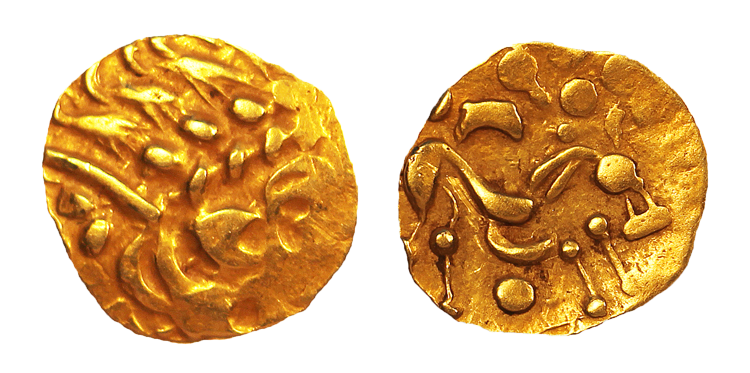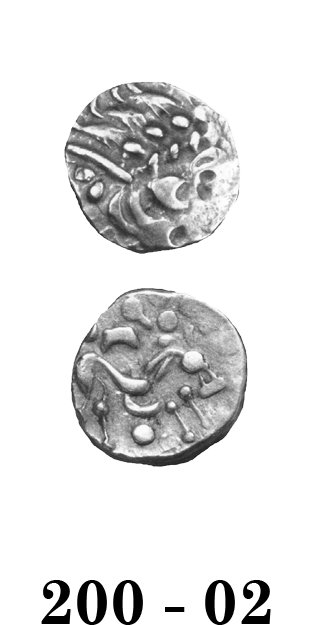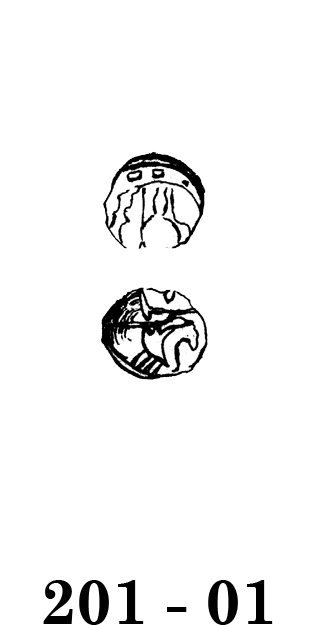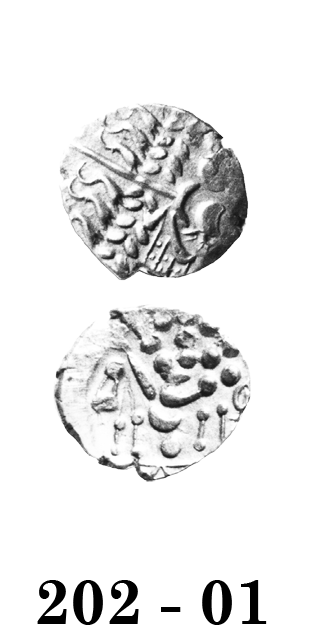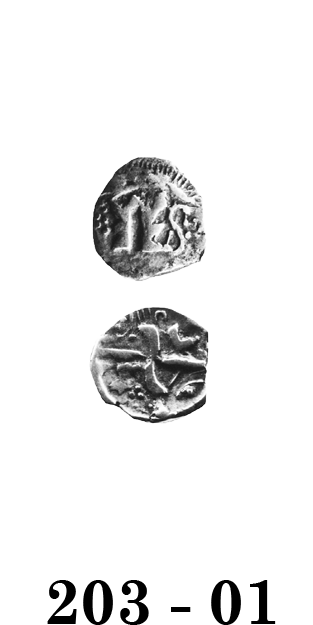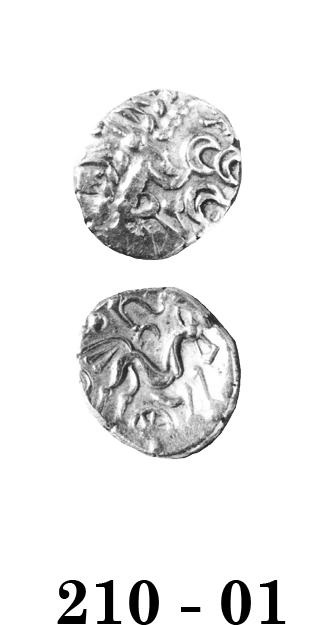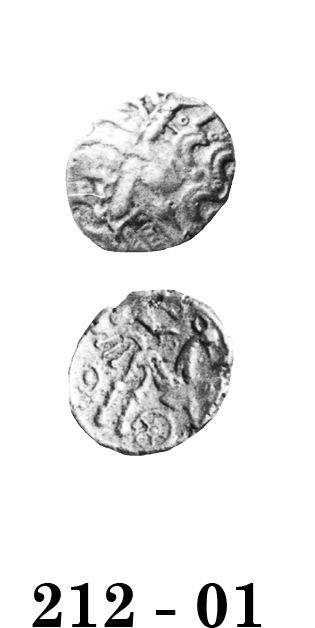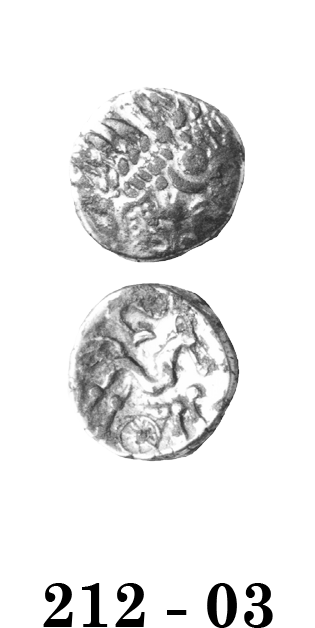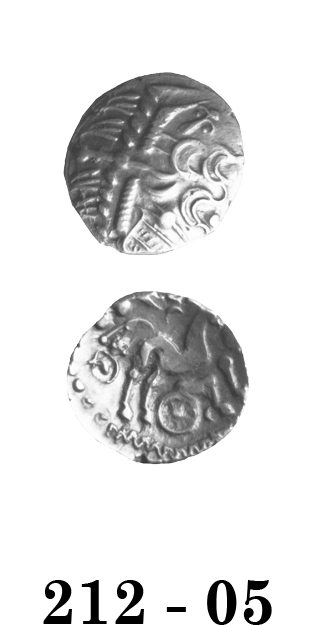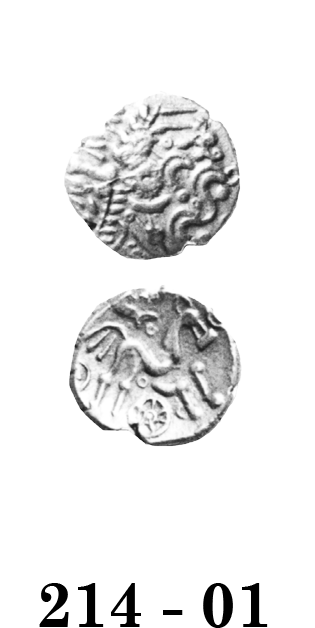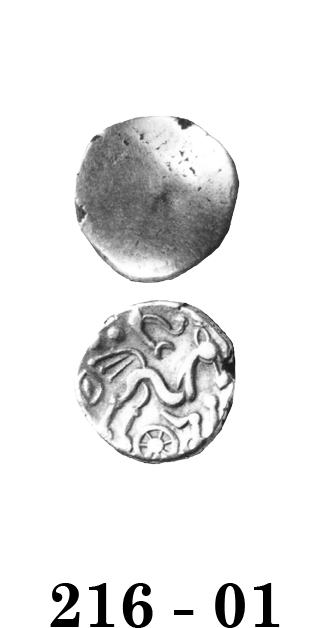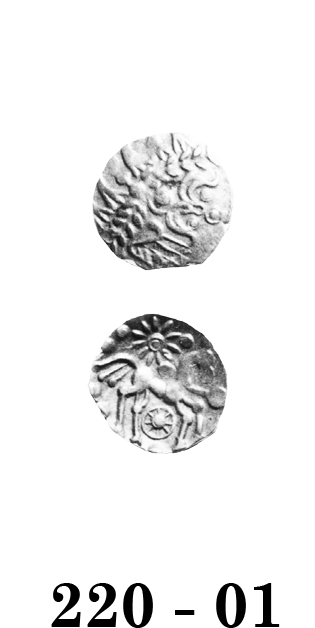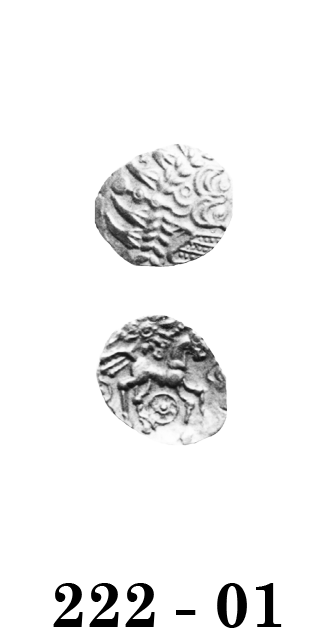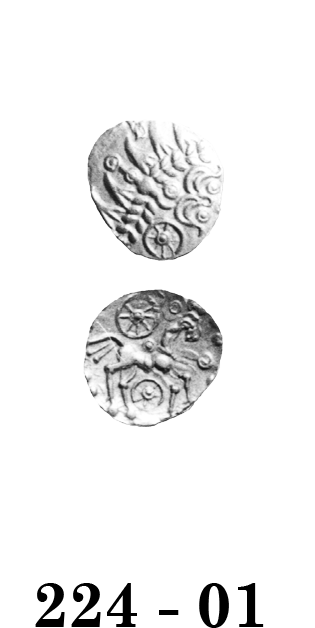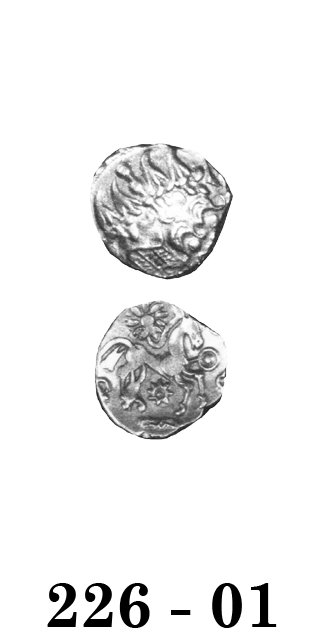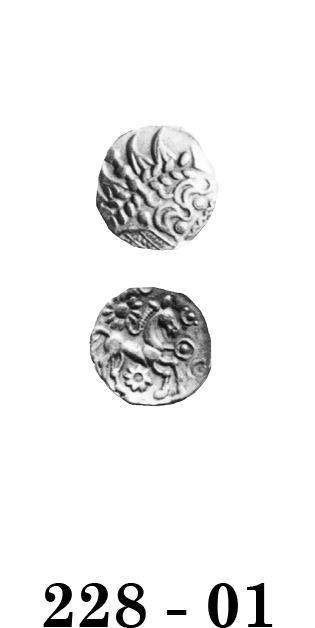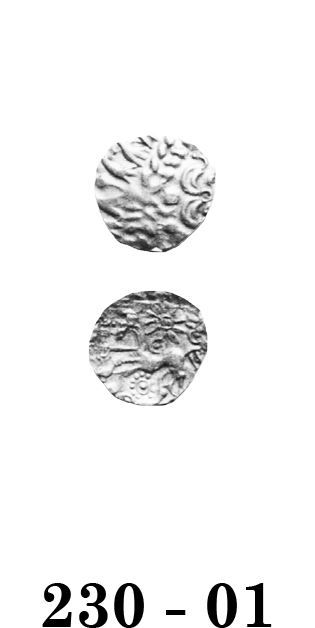
Celtic Coinage of Britain
third edition
Click on coin to see hidden information
Atrebates, Regni & Belgae Uninscribed Coinage
Imported Gaulish staters were the first coins used by the three tribes. Large Flan, Abstract Design and Gallic War Type coins are known from the tribal territory. The tribe began striking INSULAR TYPES sometime during the 60s B.C. These are heavier than their Gaulish prototypes, but lower in gold content. Around 55 B.C, the tribe struck the WESTERHAM TYPE staters, apparently a short-lived issue. The Westerham Type was replaced by the lighter ATREBATIC ABSTRACT TYPE later in the Gallic War.
The tribe produced an enormous number of staters and quarters during the war. At the time Commius was in collaboratation with Caesar, the tribe may have been part a scheme against the Durotriges, who had contacts with tribes in Brittany. They also may have received aid from the Romans seeking war materiel.
Atrebates, Regni & Belgae Abstract Gold Staters
These coins superceded the Westerham and Geometric Types later in the Gallic War.
Atrebatic Abstract Fractional Gold Staters
These are fractional denominations of which there are a large number of varieties. It is uncertain whether they should be called quarter staters and thus the term 'fractional' is used. The intricate design is struck on a small flan and crucial details may be missing. The weights vary from 1.0 to 1.4 grammes, indicating the heavier coins are actually of Gallic War date, while the lighter issues are probably post-war. The series has been catalogued by three major subtypes: Apollo heads, Apollo head variations, and alternate obverses.
Atrebates, Regni & Belgae Earliest Gold Coinage
Largely based on the work of John Sills since 1989, the earliest coinage can now be described.
During the 60s B.C., INSULAR TYPES began to be struck in the tribal territory. Later, about the middle of the Gallic War, one of the WESTERHAM TYPE staters and one of the GEOMETRIC TYPE quarter staters were stuck, possibly in response to the impending invasion of Caesar in 55 B.C.
Both of these coinages were apparently short-lived.
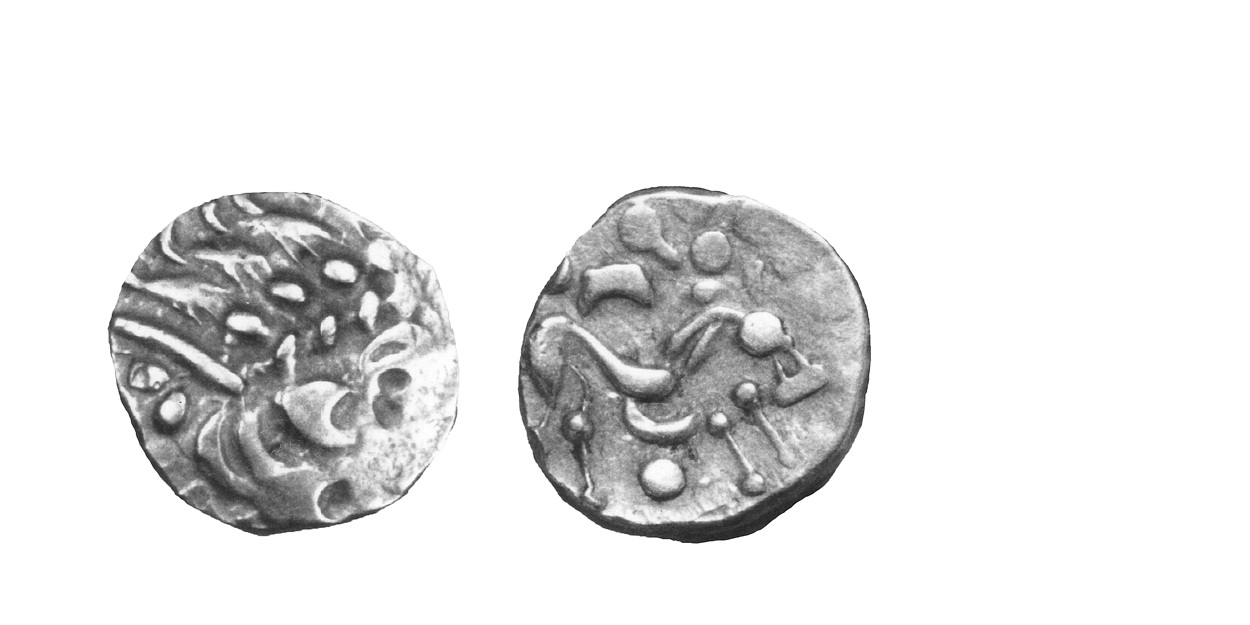
200 - 02 Insular Type
70-60 B.C. Very Rare
Gold Stater 6.45 gms. 16 mm
Earliest Record: Brooke, 1927
OBV: abstracted head of Apollo right
Identifying points:
1) head is now unrecognizable
2) face small compared to 46 - 01
3) face less dominant in design compared to 46 -01
4) overall, more abstract than Gallo-Belgic C types
REV: disjointed horse right
Identifying points:
1) horse is thin and lanky
2) overall, more abstract than Gallo-Belgic C types
CLASSIFICATION: Atrebatic A
NOTES:
- Standard weight given
- Sills has identified this as possibly the earliest type of stater struck in Britain, assigns it tentatively to the territory of the Atrebates, Regni & Belgae
John Sills has argued convincingly that this type should be assigned to the Trinovantes/Catuvellauni.
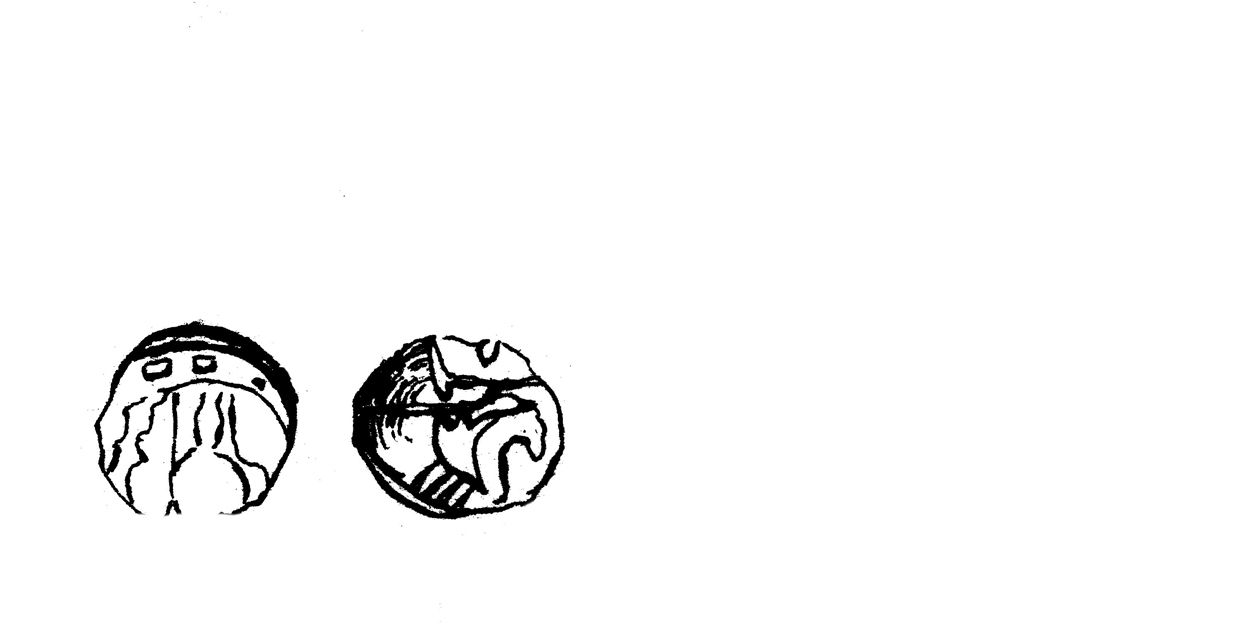
201 - 01 Insular Type
70-60 B.C. Very Rare
Gold Quarter Stater 11 mm 1.3-1.6 gms.
Earliest Record: C. Roach Smith, 1848
OBV: Large crescent and uncertain shapes
Identifying points:
1) crescent has voids
2) very abstract style
REV: Large cross-motif with pellets
Identifying points:
1) arms of cross touch
2) very abstract style
CLASSIFICATION: Atrebatic A
NOTES:
- Many in museums
- Obverse has been described as a wolf-and-twins motif or a boat with three occupants
- Sills has identified this as an Insular Type and tentatively assigned it to the territory of the Atrebates, Regni & Belgae
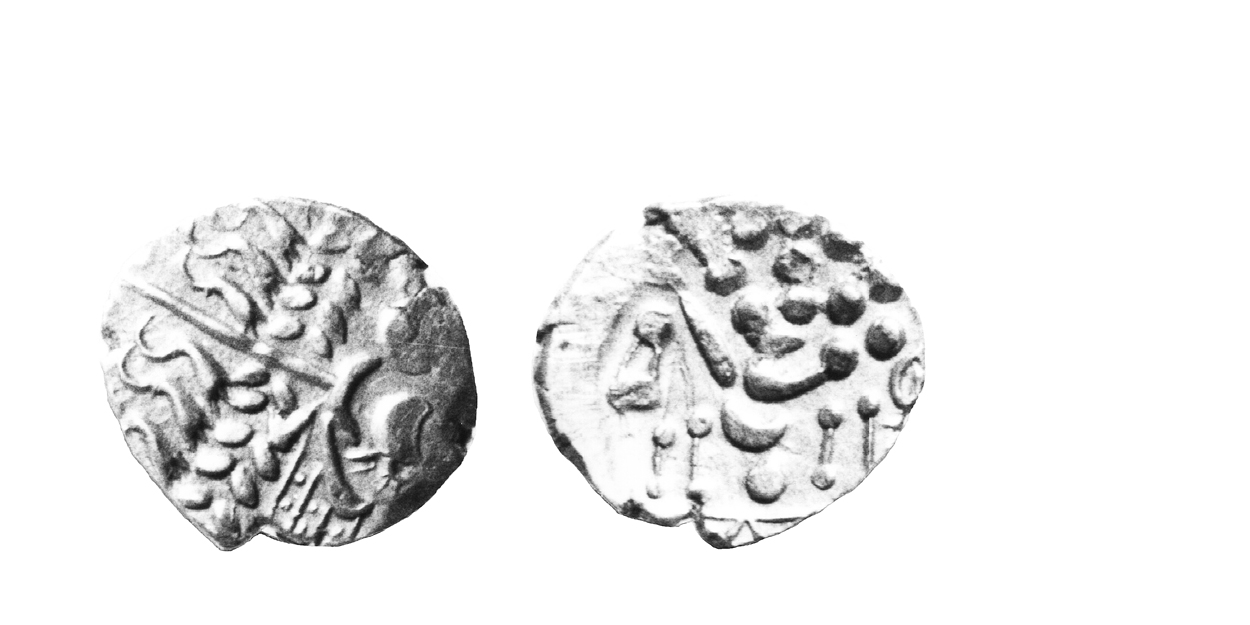
202 - 01 Westerham (Southern) Type
Ca. 55 B.C. Scarce
Gold Stater 6.5 gms. 19 mm
Earliest Record: Borlase, 1769
OBV: Abstracted head of Apollo right
Identifying points:
1) wreath: leaves "point" upwards
2) spike-with-curve
REV: Disjointed horse left
Identifying points:
1) pellet under horse
2) horse more disjointed than on imported gold staters
CLASSIFICATION: Atrebatic A
NOTES:
- Many are in museums
- Standard weight given
- John Sills has convincingly argued that this type should be dated to the mid-Gallic War
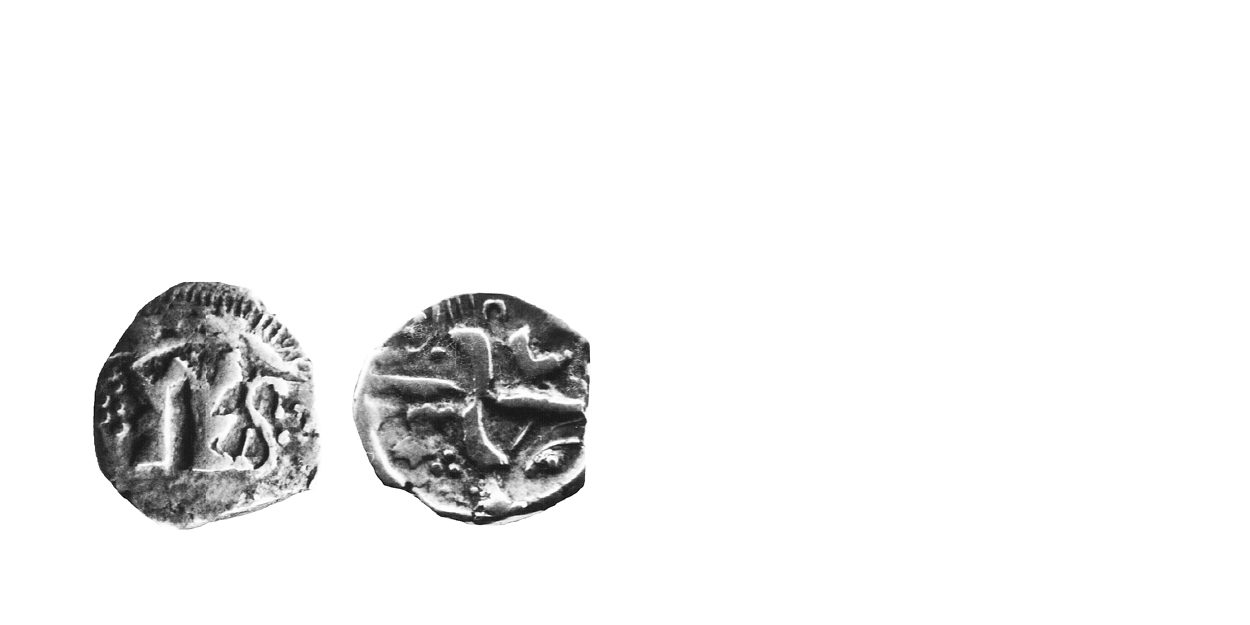
203 - 01 Geometric Type
Ca. 55 B.C. Scarce
Gold Quarter Stater 11 mm 1.3-1.6 gms.
Earliest Record: Stukeley, 1776
OBV: Large crescent and uncertain shapes
dentifying points:
1) crescent has voids
REV: Large cross-motif with pellets
Identifying points:
1) arms of cross touch
CLASSIFICATION: Atrebatic A
NOTES:
- Many in museums
- Obverse has been described as a wolf-and-twins motif or a boat with three occupants
- Originally, this type was assigned to the Cantii (143 - 01) based on a small number of findspots. Since 1989, additional finds have been identified over a much wider area and Sills has reasonably suggested the type should be assigned to the territory of the Atrebates, Regni & Belgae
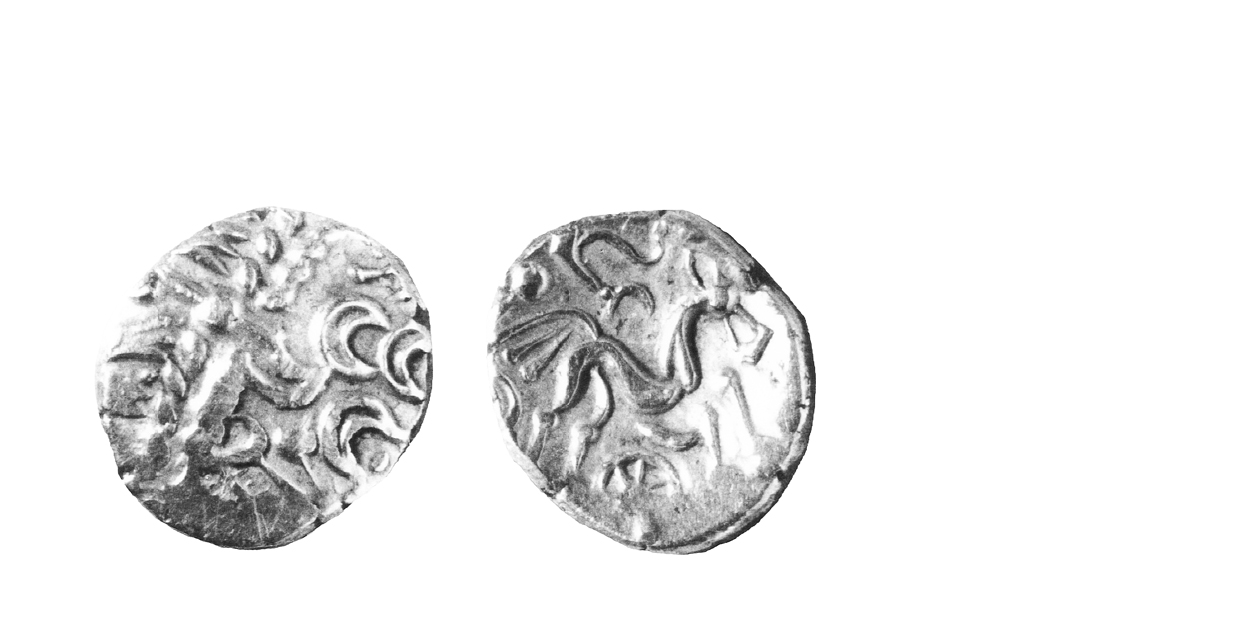
210 - 01 Atrebatic Abstract Type
55-45 B.C. Rare
Gold Stater 5.9 gms. 18 mm
Earliest Record: Petavius, 1610
OBV: Abstracted head of Apollo right
Identifying points:
1) wreath with leaves downwards, curved around face
2) spike-with-crescent has pellet terminal and one additional pellet
REV: Disjointed horse right
Identifying points:
1) horse has triple tail with pellet terminals
2) eight-spoked wheel under horse
3) horse's ear made of two curves forming oval
4) curved, zig zag exergual line
CLASSIFICATION: Atrebatic B
NOTES:
- Standard weight given
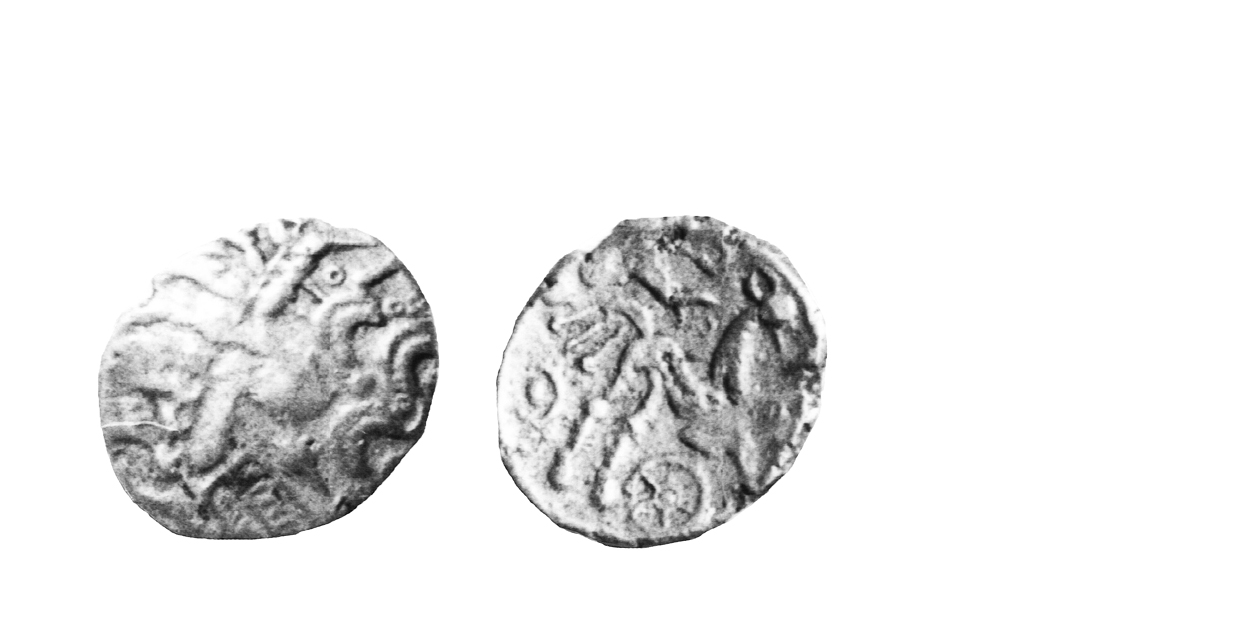
212 - 01 Atrebatic Abtract Type
55-45 B.C. Very Rare
Gold Stater 5.9 gms. 18 mm
Earliest Record: Mack, 1953
OBV: Abstracted head of Apollo right
Identifying points:
1) series of small rings scattered within hair
2) spike ornamented with three pellets
REV: Disjointed horse right
Identifying points:
1) horse has triple-tail with pellet terminals
2) horse's ear made up of two curves forming oval
CLASSIFICATION: Atrebatic B
NOTES:
- Standard weight given
- Celtic Coin Index records indicate rarer than originally thought
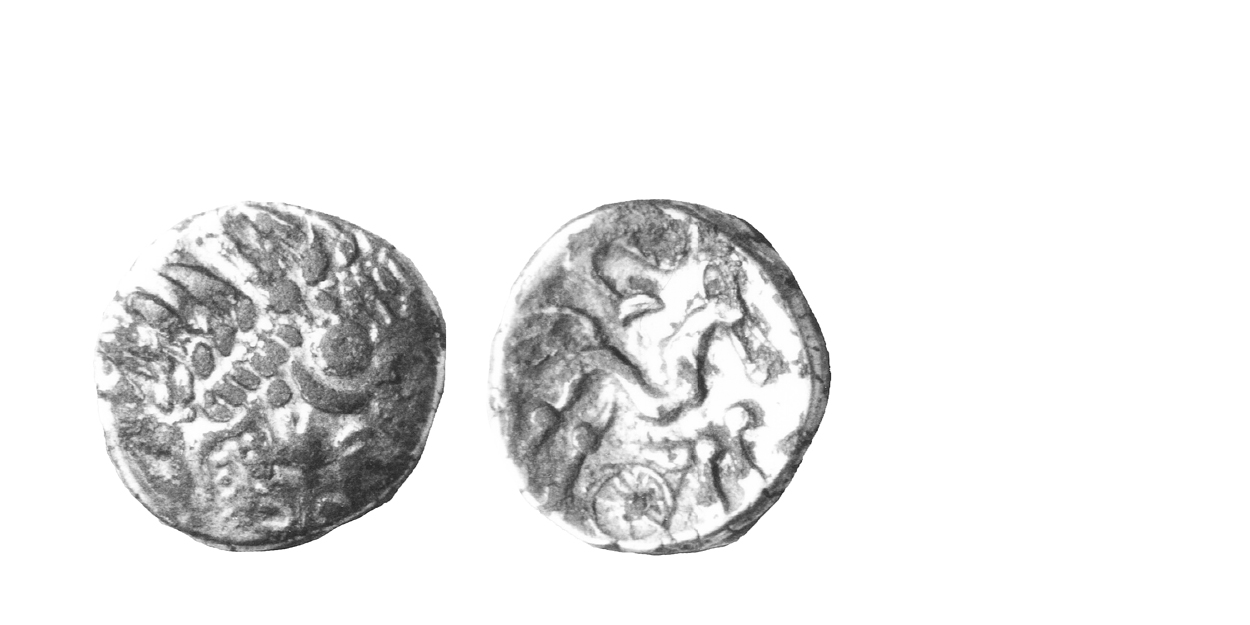
212 - 03 Atrebatic Abstract Type
55-45 B.C. Extremely Rare
Plated Gold Stater ca. 3.8 gms. 19 mm
Earliest Record: Van Arsdell, 1989
OBV: Abstracted head of Apollo right
Identifying points:
1) as 212-1
REV: Disjointed horse right
Identifying points:
1) as 212-1
CLASSIFICATION: Atrebatic B
NOTES:
- Actual weight of illustrated coin given
- Ancient forgery
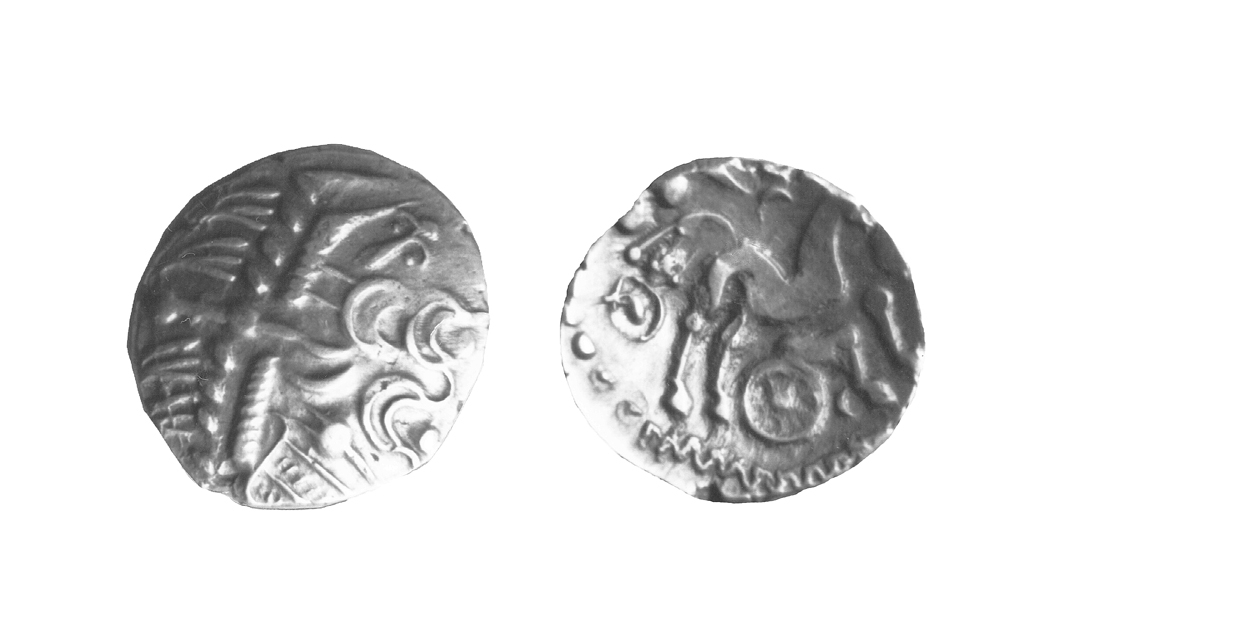
212 - 05 Atrebatic Abstract Type
55-45 B.C. Scarce
Gold Stater 5.9 gms. 19 mm
Earliest Record: Van Arsdell, 1989
OBV: Abstracted head of Apollo right
Identifying points:
1) two lines connect wreath and outline crescent
2) bird-like face hidden above outline crescent
REV: Disjointed horse right
Identifying points:
1) as 212 - 01
2) zig-zag line below horse
CLASSIFICATION: Atrebatic B
NOTES:
- Standard weight given
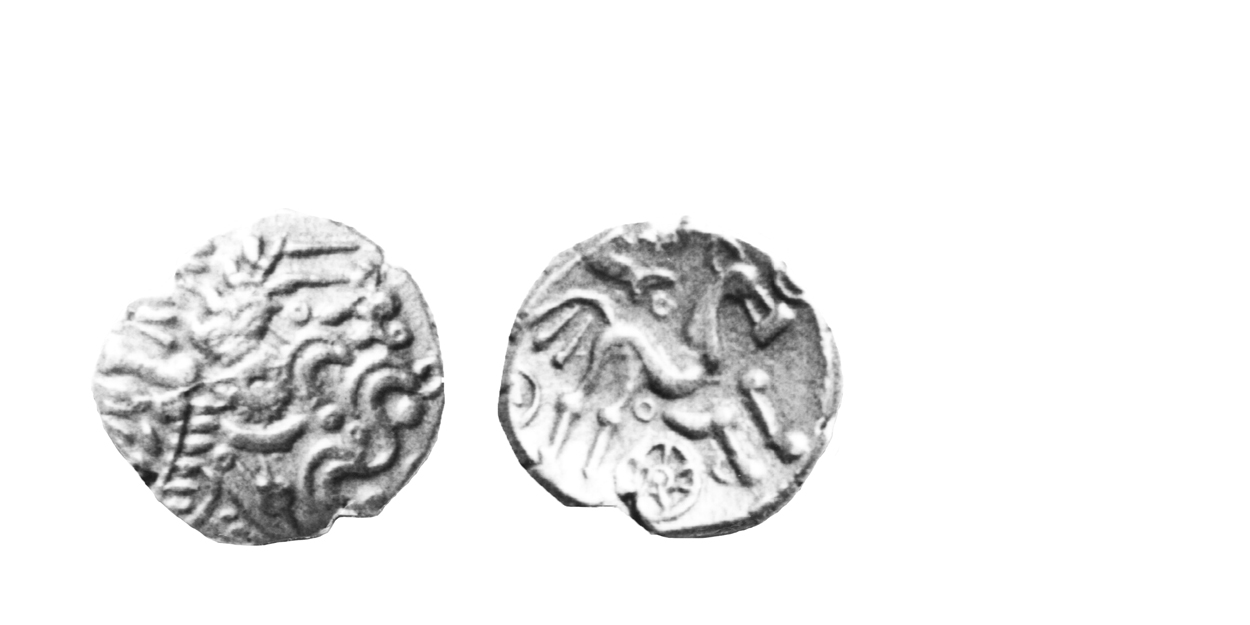
214 - 01 Atrebatic Abstract Type
55-45 B.C. Very Rare
Gold Stater 5.9 gms. 18 mm
Earliest Record: Mack, 1953
OBV: Abstracted head of Apollo right
Identifying points:
1) series of small rings scattered within hair
2) spike ornamented with three pellets or pellet-in-ring motifs
REV: Disjointed horse right
Identifying points:
1) horse has triple tail with pellet terminals
2) horse's ear made up of two curves forming oval
3) six-spoked wheel below horse
4) pellet below crescent-hand of charioteer
CLASSIFICATION: Atrebatic B
NOTES:
- Standard weight given
- Celtic Coin Index indicate rarer that originally thought
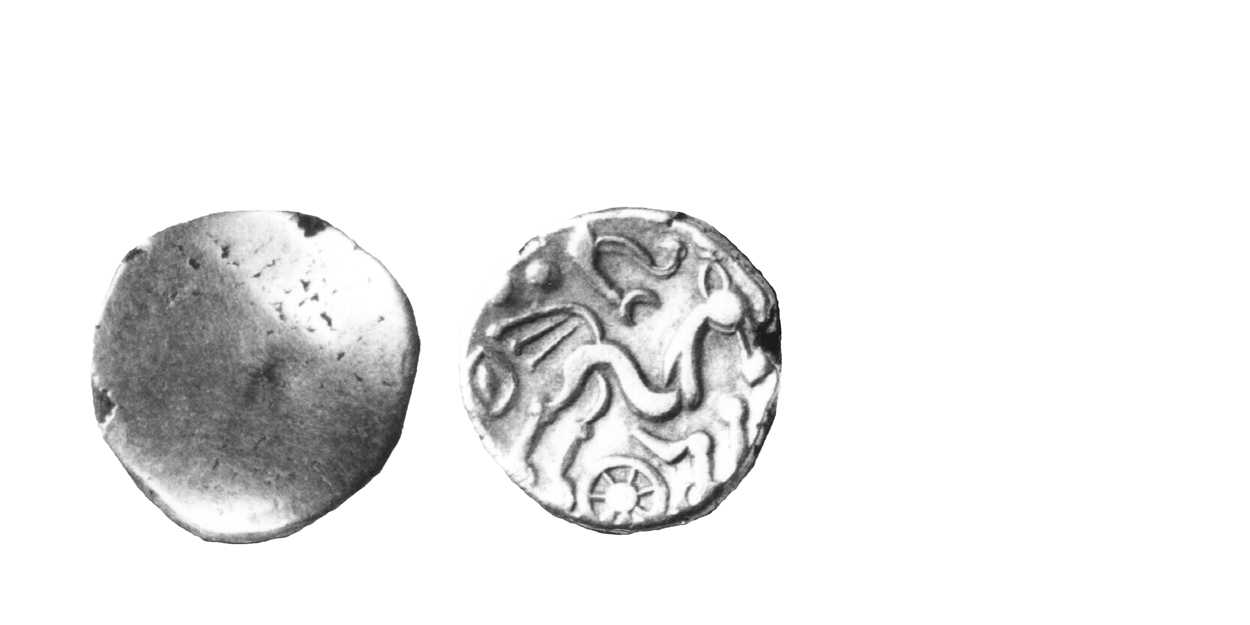
216 - 01 Atrebatic Abstract Type
55-45 B.C. Common
Gold Stater 5.9 gms. 18 mm
Earliest Record: Evans, 1864
OBV: Traditionally-styled uniface
Identifying points:
1) well worn die with abstracted head of Apollo
REV: Disjointed horse right
Identifying points:
1) horse has triple-tail with pellet terminal
2) eight-spoked wheel below horse
CLASSIFICATION: Atrebatic B
NOTES:
- Standard weight given
- Six and seven-spoked wheels also known
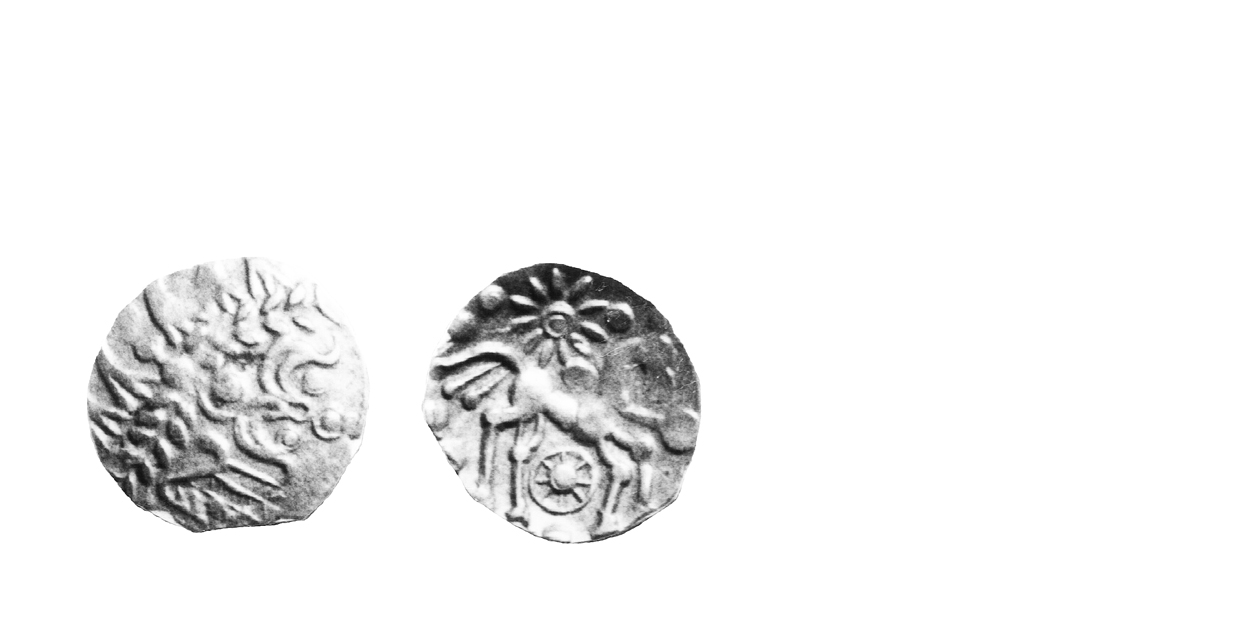
220 - 01 Abstract Type
Apollo Head
55-45 B.C. Common
Gold Fractional Stater 16 mm
Earliest Record: Evans, 1864
OBV: Abstracted head of Apollo right
Identifying points:
1) spike is decorated with three pellet-in-ring motifs
REV: Celticized horse right
Identifying points:
1) horse has triple-tail with pellet terminals
2) dahlia above horse
3) spoked wheel below horse
4) collar around horse's neck, and strap around belly beginning to emerge as distinct elements
CLASSIFICATION: Atrebatic B
NOTES:
- Some are in museums
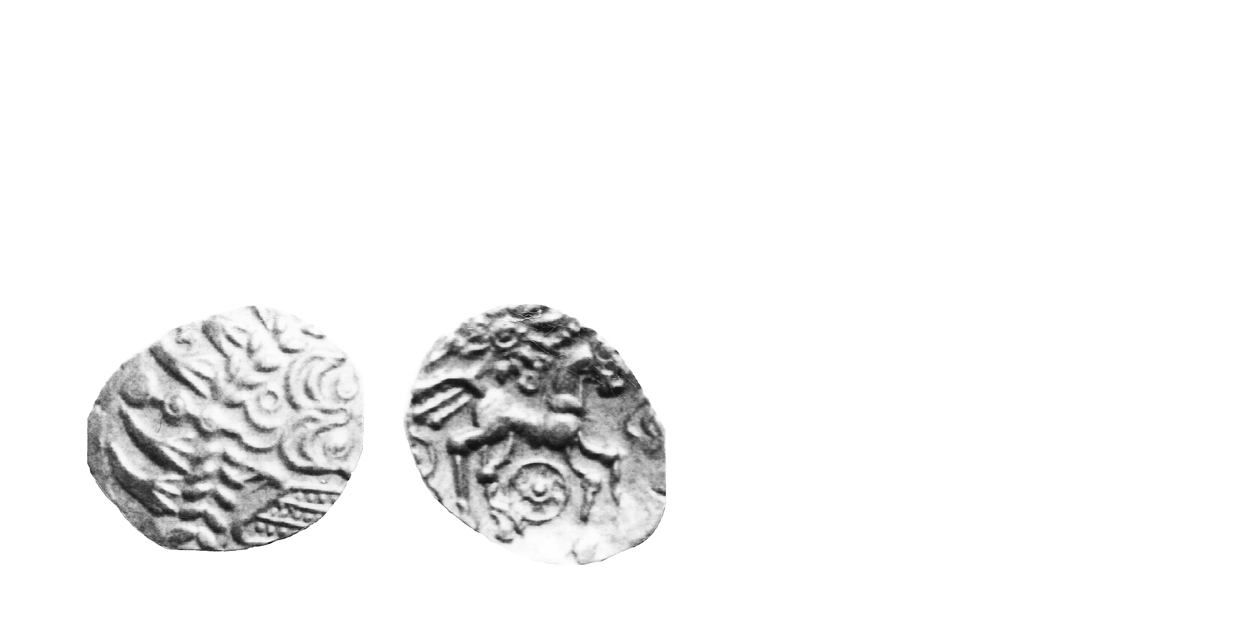
222 - 01 Abstract Type
Apollo Head
55-45 B.C. Rare
Gold Fractional Stater 14 mm
Earliest Record: Evans, 1864
OBV: Abstracted head of Apollo right
Identifying points:
1) spike is decorated with three pellet-in-ring motifs
REV: Celticized horse right Identifying points:
1) horse has triple tail with pellet terminals
2) complex flower with pellet-in-ring motif at centre
3) spoked wheel with axle
4) collar around horse's neck
5) strap around horse's belly
CLASSIFICATION: Atrebatic B
NOTES:
- Many are in museums
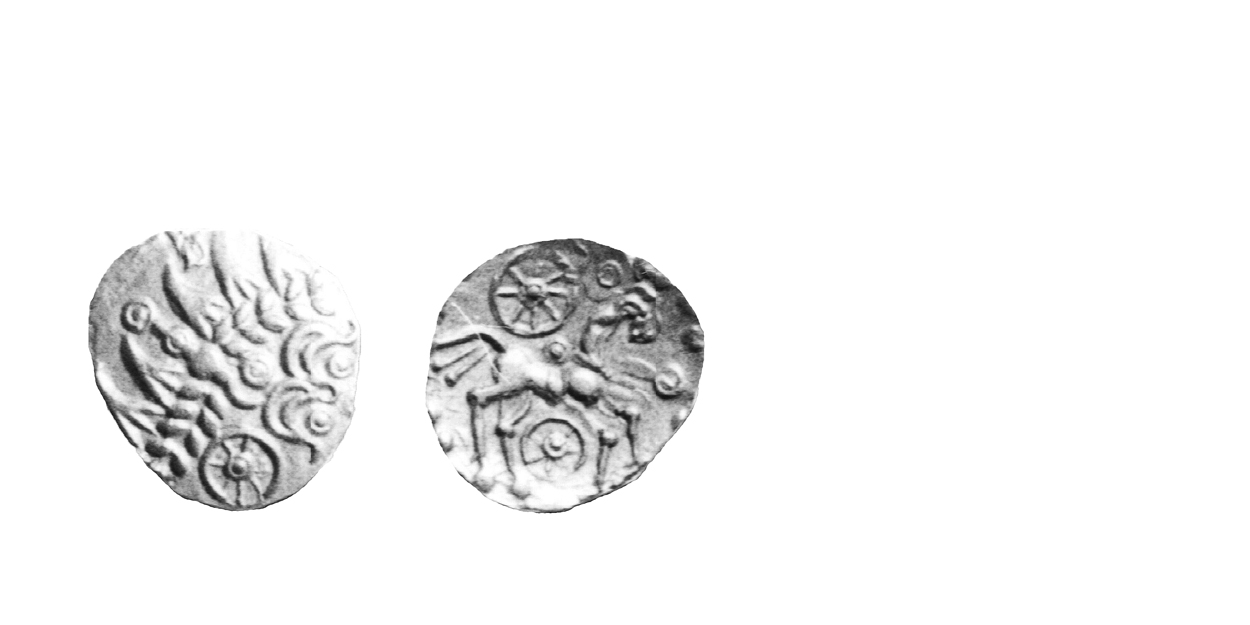
224 - 01 Abstract Type
Apollo Head
55-45 B.C. Extremely Rare
Gold Fractional Stater 15 mm
Earliest Record: Evans, 1864
OBV: Abstracted head of Apollo right
Identifying points:
1) seven or eight-spoked wheel with axle
2) spike ornamented with three pellet-in-ring motifs
REV: Celticized horse right
Identifying points:
1) horse has triple-tail with pellet terminals
2) collar around horse's neck
3) strap around horse's belly
4) eight-spoked wheel with axle above and below horse
CLASSIFICATION: Atrebatic B
NOTES:
- Many are in museums
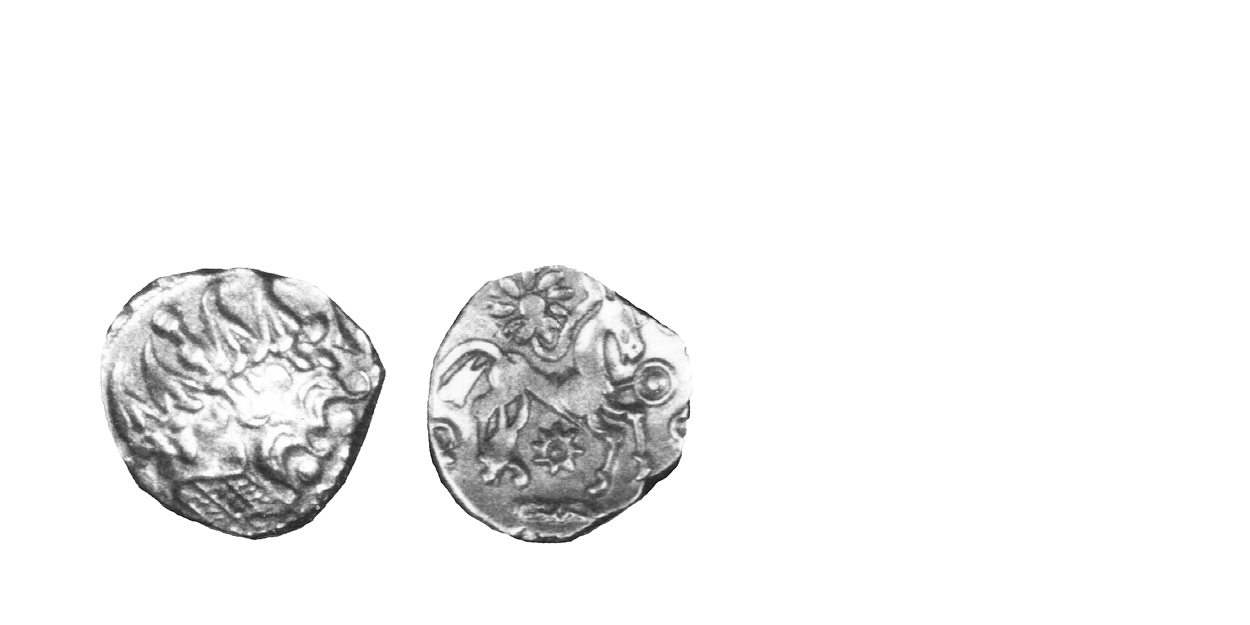
226 - 01 Abstract Type
Apollo Head
55-45 B.C. Scarce
Gold Fractional Stater 12 mm
Earliest Record: Evans, 1864
OBV: Abstracted head of Apollo right
Identifying points:
1) spike ornamented with four pellets
REV: Celticized horse right
Identifying points:
1) horse has triple-tail with pellet terminals
2) three solid crescents above horse
3) strap around horse's belly
4) dahlia above horse
5) cog wheel below horse
CLASSIFICATlON: Atrebatic B
NOTES:
- Some are in museums
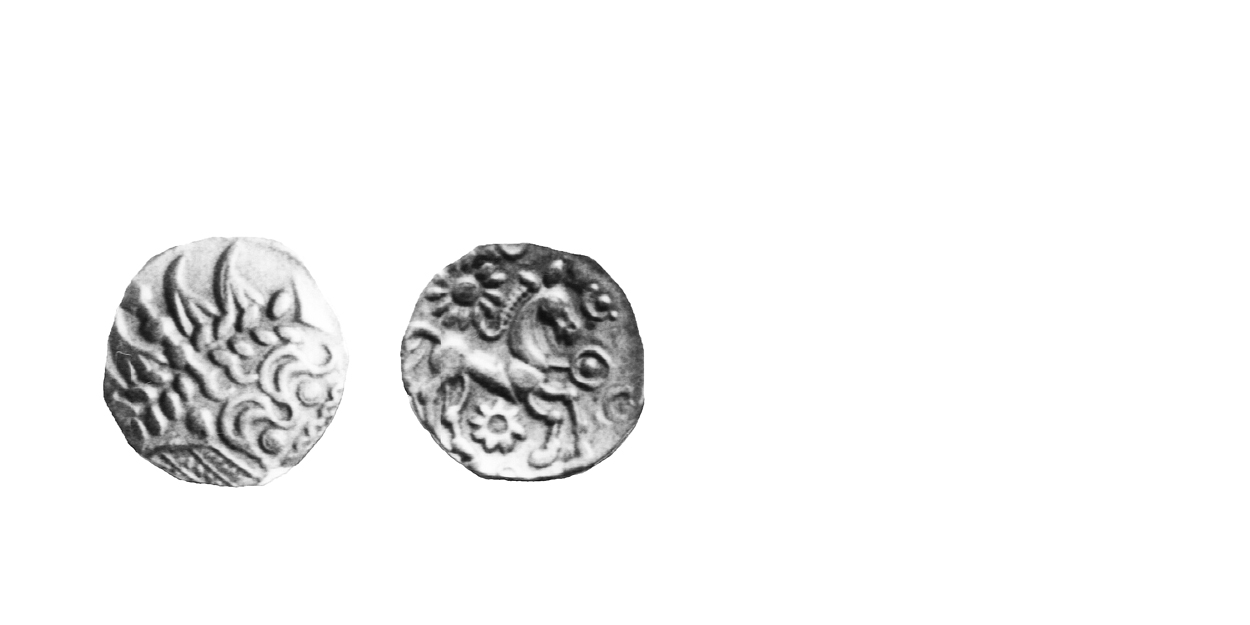
228 - 01 Abstract Type
Apollo Head
55-45 B.C. Scarce
Gold Fractional Stater 12 mm
Earliest Record: Evans, 1864
OBV: Abstracted head of Apollo right
Identifying points:
1) spike ornamented with three pellets or pellet-in-ring motifs
REV: Celticized horse right
Identifying points:
1) horse has triple-tail probably with pellet terminals
2) eleven-petalled flower with uncertain centre
3) cog wheel without central pellet below horse
CLASSIFICATION: Atrebatic B
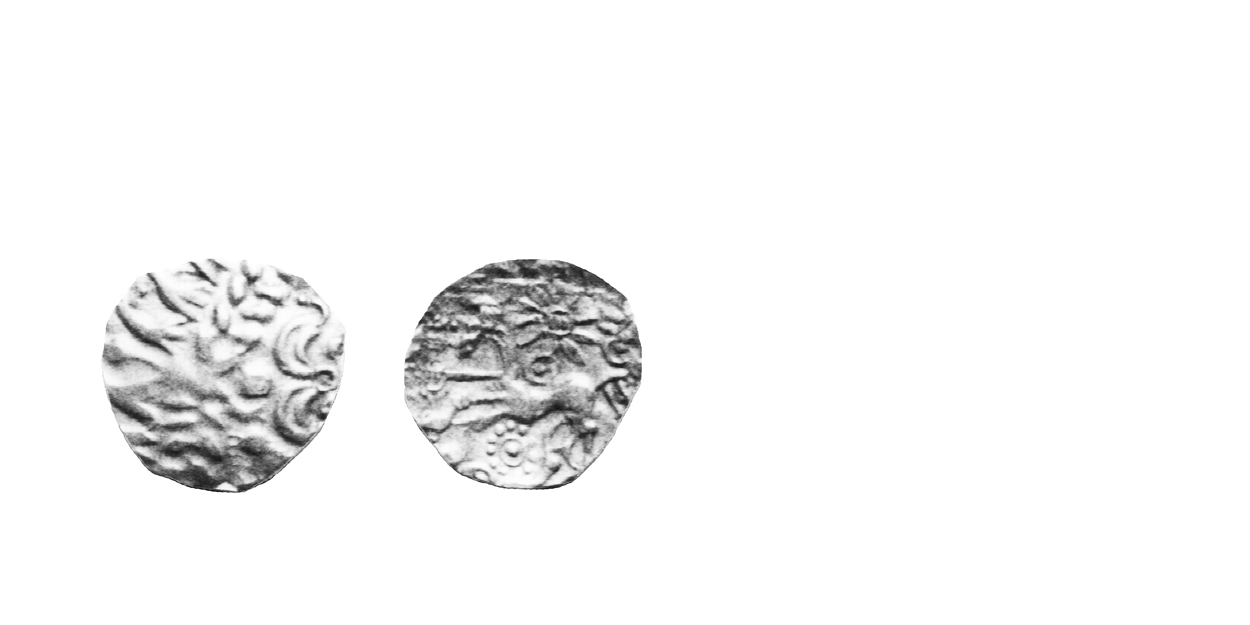
230 - 01 Abstract Type
Apollo Head
55-45 B.C. Extremely Rare
Gold Fractional Stater 12 mm
Earliest Record: Mack, 1953
OBV: Abstracted head of Apollo right
Identifying points:
1) spike ornamented with three pellets
REV: Celticized horse left
Identifying points:
1) horse has triple tail
2) strap around horse's belly
3) dahlia above horse
4) anemone below horse
CLASSIFICATION: Atrebatic B
NOTES:
Most are in museums
Coinage of the Atrebates, Regni & Belgae
The Atrebates, Regni and Belgae occupied the territory that is today Berkshire, Sussex and Hampshire. Whether three distinct political groups struck coins cannot be proven today, nor can separate territories be demonstrated. The Regni are virtually unknown to history until the Roman period, and the tribal area of the Belgae is a matter of controversy. Though Belgic immigration is mentioned by Caesar, he does not specifically say where they settled, and we only have the Roman name Venta Belgarum to suggest a location. The Atrebates, also mentioned by Caesar, had tribal members on both sides of the Channel.
Traditionally, the three tribes have been treated numismatically as one. Based on the current state of research, there is no reason to change this approach. Attempts have been made to identify a separate coinage for the Belgae. These have been largely, but not entirely, based on reports of new types of silver coins published in numismatic trade lists since 1994. The coins do not appear to form a coherent issue of a single issuing authority and questions exist regarding their precise status. These enigmatic coins demand careful analysis and reflection before they are accepted as evidence for a Belgic coinage. Certainly, after the Gallic War, only one coinage circulated in the territory. It may someday come to pass that coinages for the Belgae and Regni can be identified, but only after a rigorous analysis of the new types has been completed. Most of these are listed under "New Material". For the remainder of this discussion the three tribes will be referred to simply as the "Atrebates" for the sake of brevity.
Initially, the three tribes constituted one of the most advanced groups in Britain. They had trading contacts with Belgic Gaul in the late second and early first centuries B.C., and were one of the earliest to strike coins. The earliest stater, the INSULAR TYPE struck before the Gallic War, is derived from imported Gallo-Belgic C. The next coinage, the WESTERHAM TYPE, is now felt to be inspired by the Trinovantian/Catuvellaunian coinage of the same name, struck during the Gallic War. After the war, the tribal position changed dramatically, and the Atrebates may have fallen out of favour with the Romans. It is possible the cross-Channel trading rights were given to the Trinovantes/Catuvellauni instead. A loss of trading rights may have been the result of Commius' activities during the War.
Commius, at first a supporter of Caesar, became disillusioned with the Romans and went over to Vercingetorix. After the collapse of Celtic resistance at Alesia, he fled to join the British part of his tribe. Later, the Atrebates struck coins with his name, and possibly the acceptance of Commius in Britain was the reason they fell out of favour. The change in trading rights altered the relative fortunes of the two tribes forever. By the end of the millennium, the Trinovantes/Catuvellauni had economic influence throughout southern Britain and had begun to rival the Atrebates.
The Atrebates seized the opportunity of the Trinovantian/Catuvellaunian Interregnum to mount a military incursion into Kent under their leader, Eppillus. Eppillus struck a victory stater commemorating the initial success of the expedition. The incursion was cut short, however, by the elevation of Cunobeline to the Trinovantian/Catuvellaunian throne. He drove the Atrebates out of Kent and Eppillus promptly disappeared. He is replaced on the coins by Verica, a self-styled 'son of Commius'.
Sometime before the Claudian invasion, Verica was in turn overthrown. He probably was the historical Celtic leader 'Bericus' who appeared in Rome seeking aid from Claudius. Verica was replaced on the coins by Epaticcus, who styled himself a 'son of Tasciovanus'. Whether the family-tie was real is not so important, the result was the Atrebatic leadership was now held by a Trinovantian/Catuvellaunian sympathizer. Shortly before the Claudian invasion, Epaticcus was replaced by Caratacus, the famous leader of the British resistance against the Roman invaders. The Atrebatic coinage came to an end during the forties, as Caratacus fled westwards to lead the resistance amongst the tribes in Wales. One Atrebatic leader known to history, Cogidubnus, has not yet been identified on the coinage. It seems he was not elevated to leadership until the coinage had come to an end.
The oppidum of Calleva, Silchester today, was the site of an Atrebatic mint, and the name Calleva appears on coins of Eppillus. Other leaders may have had mints elsewhere, but none have been identified. Plausible mint sites for separate Belgic or Regnan coinages have not been identified.
